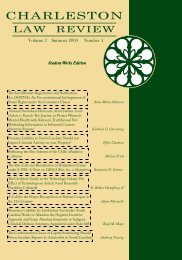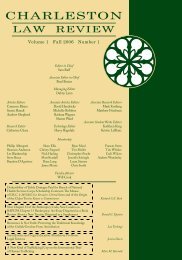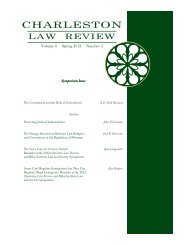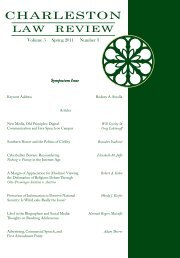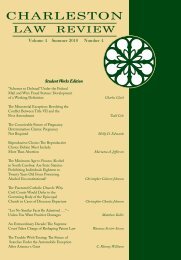Volume 5 Winter 2011 Number 2 - Charleston Law Review
Volume 5 Winter 2011 Number 2 - Charleston Law Review
Volume 5 Winter 2011 Number 2 - Charleston Law Review
You also want an ePaper? Increase the reach of your titles
YUMPU automatically turns print PDFs into web optimized ePapers that Google loves.
SCHULZE FINAL.doc1/20/<strong>2011</strong> 6:14PM<strong>2011</strong>] <strong>Law</strong> School Academic Supportstressors cannot be eliminated. Thus, one might say that lawschools should eliminate stressors that are pedagogicallyunnecessary while empowering students to cope with thestressors that are necessary for a rigorous education. Forinstance, exams cause stress, but they certainly cannot beeliminated. Furthermore, frequent formative assessment 69 mightcause stress, but it is actually a method pedagogically preferableto one exam at the end of a course representing the totality ofone’s grade. In that instance, frequent formative assessment,while increasing the number of stressors students face, willultimately reduce the aggregate quantity of stress created by onesummative assessment. It also provides a more rigorouseducation because students are tested more frequently. In thisway, humanizing can both prevent psychological harm tostudents and provide rigorous training. 70Professor Glesner Fines’s second principle of humanizing isthe notion of teaching students, not subjects. 71 Put another way,law schools should move—like most of the rest of the academy—toward a student-centered educational model. Initiatives in thisarea include training students how to teach themselves, 72teaching students to discern their preferred learning style, 73understanding generational differences in learning, 74 and69. “Formative assessment is the evaluation of student performanceduring a learning process of prescribed term, while final [or summative]assessment is evaluation at the end of the term.” Jay M. Feinman, <strong>Law</strong> SchoolGrading, 65 UMKC L. REV. 647, 647 (1997); see also ROY STUCKEY ET AL., BESTPRACTICES FOR LEGAL EDUCATION 255 (2007) (encouraging the use of formativeassessments throughout the semester).70. Another more subtle example of the principle of “do no harm” couldinclude expanding this to “permit no vicarious harm.” For instance, ProfessorRebecca Flanagan details how law school bullying undermines learning andcreates an emotional impediment to successful legal education. See RebeccaFlanagan, Lucifer Goes to <strong>Law</strong> School: Towards Explaining and Minimizing<strong>Law</strong> Student Peer-to-Peer Harassment and Intimidation, 47 WASHBURN L.J.453, 453–57 (2008) (discussing the impact of student bullying in law schools andexplaining faculty or administration-based solutions).71. Fines, supra note 37, at 318–22.72. See generally Schwartz, Teaching <strong>Law</strong> Students, supra note 40(explaining the process of Self-Regulated Learning).73. MARTHA M. PETERS & DON C. PETERS, JURIS TYPES: LEARNING LAWTHROUGH SELF-UNDERSTANDING 9–10 (2007).74. Susan K. McClellan, Externships for Millenial Generation <strong>Law</strong>291



